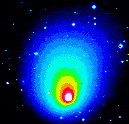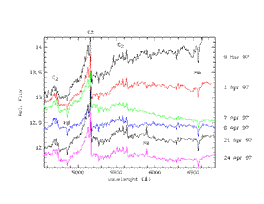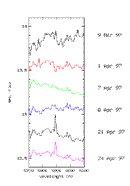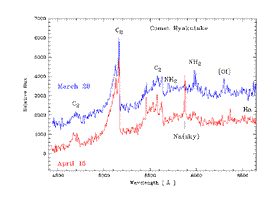![[ ESO ]](eso-logo.gif) |
Comet Hale-Bopp's spectrum observed from Garching |

MPI/ESO 2.2-m + EFOSC II (May 14, 1996)
|
Gerardo Avila, Jesus Rodriguez, Carlos Guirao and Juan
M. Alcala
European Southern Observatory and Max-Planck Institute
for Extraterrestrial Physics
Garching, Germany
May 5, 1997
Six low-dispersion spectra of the Comet Hale-Bopp were recorded from
the European Southern Observatory in the vicinity of Munich during the period
9 March to 24 April, 1997. The spectra were obtained by Gerardo Avila, Jesus
Rodriguez, Carlos Guirao (avid amateur astronomers from ESO) and Juan M.
Alcala (not less and from the Max-Planck Institute for Extraterrestrial
Physics) with a home-made spectrograph, attached to an amateur telescope
with fibre optics. We present here the spectral tracings.

Sodium in Hale-Bopp
 |
Of particular interest in these observations is the evolution of the Sodium
emission line observed in the core of the comet. The corresponding spectral
region is seen on these spectral tracings (left).The line is clearly visible
on top of the spectral continuum (the reflected sunlight from the dust)
in the last two runs (21 and 24 April), just after the discovery of the
Na tail ( the
23th April ).Note that this sodium doublet (in our spectra it is
blended due to the low resolving power) seems to appear already in the first
spectrum obtained on March 9, 1997. |
However, its presence in that spectrum may be due to the background light
of the close city of Freising or the Munich Airport which were located at
angular distances of about 60° and 80° from the comet, respectively.
Still, we believe that this is a real emission line from the comet since
the exposure times were relatively short (around 80 sec). Unfortunately
for this specific observation we have no nearly simultaneous, recorded sky
exposure to confirm this assumption. On the following spectra, the Na line
is not present (1, 7 and 8 April, 1997).
The equipment
A description of the equipment used for these observations follows:
- Telescope: 25cm Schmidt-Cassegrain, F/6.3 in a Alt-Az mount.
- Fibre optics: 0.2mm core diameter and 4m long. Sky aperture:
21 arcsec.
- Spectrograph:
- Collimator: Doublet lens with 300mm focal distance
and f/6. Grating: 600 grooves/mm 50mm x 50mm blazed at 500nm.
- Camera optics: Photographic Objective, 100mm focal distance
and F/2.2.
- Dispersion: 0.43nm/mm. Resolving power: 600 (1nm).
Spectral range: 220 nm.
- CCD Camera: Hale Research (GB) equipped with a Tektronix CCD
512x512, 27 micron pixel, thermo-electric cooling system. Estimated read
out noise: 100 electrons(!).
- Hardware and Software: Portable PC 486, 33 MHz, 16Mb RAM, 500Mb
Harddisc. Linux 1.2.13 operating system with DOS emulator. The data reduction
was performed with ESO-MIDAS packages release 95NOV pl2.0 installed in
this PC.
- Data reduction: All the spectra were reduced using the contexts
LONG and SPEC of the ESO
MIDAS system.
- During each observation run, spectra of a helium-argon calibration
lamp, flat-fields and spectrophotometric standard stars were recorded.
Each of the Hale-Bopp comet spectra shown in the accompanying figures,
except that on March 9, have been averaged from 3 or 4 individual exposures.
In accordance to the sky clearness and altitude, the comet exposures ranged
between 80 and 300 seconds. The spectra were also bias and dark-current
subtracted. The relative flux correction was performed with the help of
Etha Ursae Majoris (HR5191) as standard star. The spectra are not, however,
corrected by the Sky Rayleigh dispersion.
Go
to ESO Hale-Bopp Homepage
Coming back to Hyakutake
The exciting discovery of the third Na tail in Hale-Bopp motivated us
to revisit the spectra obtained of Comet Hyakutake last year.

The recording shows two spectra obtained by the same team on March 28
and April 16, 1996.
The first result, which was already published on the web last year (click
here), shows the `standard' comet spectrum in the visible region.
The second shows a relatively intense Na-line.
One important point in this connection is the location of the comet on
the day of the observation when it was extremely low in the sky (about 15°
above the horizon!). Under these conditions, the background citylight pollution
is particularly high. For this reason, we thought that this peak must have
been produced by the Na street lights and unfortunately no `sky exposure'
was recorded to evaluate its contribution in the spectrum.
However, on 24 April this year (1997) we took a similar exposure towards
the same sky location with a mid-cloudy sky during 20 min and we did not
find any Na pollution.
We transmit this result to the astronomical community in the hope that
there is somebody somewhere who is able to confirm the presence of this
emission line in Hyakutake.



![[ ESO ]](eso-logo.gif)
![[ ESO ]](eso-logo.gif)